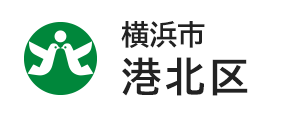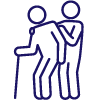The text is from here.
History of Kohoku Ward
Last updated on March 15, 2024.
Kohoku Ward was born at the same time as Totsuka Ward in April 1939. At that time, Kohoku Ward was a combined area of Kohoku Ward, Midori Ward, Aoba Ward and Tsuzuki Ward , with a population of about 50,000.
In 1969, Midori Ward (now part of Midori Ward, Aoba Ward and Tsuzuki Ward ) was divided, and in November 1994, the northwestern part of the ward was incorporated into Tsuzuki Ward to form the current Kohoku Ward.
With the opening of the current JR Yokohama Line in 1908 and the current Toukyu Toyoko Line in 1926, Kohoku Ward became the first inland area of Yokohama to become urbanized. In the early Showa era, Tsunashima Onsen was bustling, Keio University Yoshina moved to Hiyoshi, and residential land development was seen around Toukyu Toyoko Line stations.
From the early post-war period to the period of high economic growth, the development of residential land in farmland and forest areas and the conversion of land use from farmland to factories and warehouses progressed. In particular, factories have been concentrated around the Tsurumi River, making it a major base for inland industry in Yokohama City.
In 1964, when Shin-Yokohama Station opened along with the opening of the Tokaido Shinkansen, a land readjustment project for the northern part of Shin-Yokohama Station was started, and it became the second base in Yokohama City after Yokohama Station, Kannai and Kangai-District.
In 1985, high-speed railway line 3 connecting Yokohama and Shin-Yokohama was opened, and in 1993 it was further extended to Azamino (Aoba Ward), and Shin-Yokohama Station (currently Kita Shin-Yokohama Station: renamed in August 1999) and Niwa Station became established. Also, in other semi-industrial areas, the transition to housing is progressing rapidly.
The area including small desks and Niiba around Shin-Yokohama Station is positioned as the center of Shin-Yokohama in the Yokohama City's comprehensive plan "Yumehama 2010 Plan", and the development of wide-area facilities and infrastructure is being planned. One of them is the opening of the Yokohama International Stadium (now Nissan Stadium) in 1998.
| Ages | Christian era | Year | Year | Sir | Population | The world |
|---|---|---|---|---|---|---|
| 900s | The names of townships such as Takada, Tachibana-gun and Shioka, Kuraki-gun are written in "Wamyoruijusho". | Nara-Heian period | ||||
| 1200s | Samurai such as Shioka and Tsunashima of Musashi Country appeared in "Azuma Kagami Kagami" | Kamakura period | ||||
| 1400 | 1405 | Oei era | 12 | "Siansho" contains a letter of intent when the bridge memorial service was held in Tsunashima-go. | Muromachi period | |
| 1476 | Civilization | 8 | Small desk battle (Michio Ota [Otadokan] captures Kodesk Castle) | |||
| 1486 | 18 | It is written in "Kaikoku Zaki" that you will rent an inn in Komabayashi. | ||||
| 1800 | 1834 | Tenpo era | 5 | At this time, Hiroshige Ando stayed at Senya-ji Temple in a small desk. 8 Sugito "Yamazakura Kotori Color Paintings" are left. | ||
| 1859 | Yokohama Port Opening | Kaei 6 (1853) arrived at Kurofune Uraga | ||||
| 1871 | Meiji | 4 | It is located in Kanagawa Prefecture due to the abolished feudal prefecture | |||
| 1889 | 22 | Municipal system is enforced in Yokohama. Koseki Village, Otsuna Village, Hiyoshi Village, etc. are organized. | ||||
| 1900 | 1904 | 37 | Peach cultivation in Tsunashima begins | |||
| 1908 | 41 | Facility between Yokohama and Hachioji Yokohama Railway (the predecessor of the Yokohama Line) opened | ||||
| 1910 | 1912 | Taisho | Source: | The Tsunashima Orchard Art Association is established | ||
| 1914 | 3 | Radium mineral springs out in Tsunashima, Tarumachi. | World War I (~ 1918) | |||
| 1917 | 6 | The Yokohama Line will be nationalized | ||||
| 1920 | 1923 | 12 | Great Kanto Earthquake | |||
| 1926 | 15 | Between Maruko Tama River and Kanagawa Tokyo Yokohama Electric Railway Kanagawa Line (the predecessor of Toukyu Toyoko Line) opened Opening of Yokohama Railway Kikuna Station | ||||
| 1927 | Showa | 2 | Ward administration enforcement The 5 wards of Tsurumi, Kanagawa, Hodogaya, Naka and Isoko are born in Yokohama City Shinohara-cho, Kikuna-cho, Soyado-cho, Taio-cho, Osone-cho, Tarumachi, Minami-Tsunashima-cho, Kita-Tsunashima-cho, Shioka-cho, Kishinecho, Toriyamacho and Kozukuecho were transferred to Kanagawa Ward. Tokyo Yokohama Electric Railway Tsunashima Hot Spring Bath opened | |||
| 1928 | 3 | Opened a natural skating rink in Ozone (it became Okurayama skating rink in 1936) | ||||
| 1930 | 1931 | 6 | Tokyo Yokohama Electric Railway and Okurayama Umebayashi Corporation | Manchuria Incident | ||
| 1932 | 7 | Opening of the entire Toyoko Line between Shibuya and Sakuragicho Construction of Okurayama Psychiatry Research Institute | 5.15 Cases | |||
| 1934 | 9 | Relocated to Keio University Preliminary School, Hiyoshi | 2.26 in 1936 | |||
| 1938 | 13 | Heavy rain destroyed the embankment of Tsurumi River and damaged | 1937 Rohzo Bridge Incident [Rokkokyojiken] | |||
| 1939 | 14 | The birth of Kohoku Ward (approximately one-third of the entire city area) | 51,800 | Nomonhan 5/11 incident | ||
| 1940 | 1941 | 16 | Direct operation of the Yokohama Line (Higashikanagawa to Hachioji) | Outbreak of Pacific War | ||
| 1942 | 17 | Completed relocation to the ward office Kikuna Opening of Kikuna Girls' School | ||||
| 1944 | 19 | Naval Headquarters stationed at Keio University Hiyoshi Campus Opened Tsunashima Park as an air defense green space | ||||
| 1945 | 20 | U.S. forces stationed at Hiyoshi Campus of Keio University | 86,314 | Great Yokohama Air Raid Hiroshima and Nagasaki Atomic Bombs End of the war | ||
| 1946 | 21 | Established the ward election committee for the first time, appointed a member of the public welfare committee | Enforcement of the Constitution of Japan | |||
| 1947 | 22 | Municipal bus opening for the first time in the city Okurayama Natural Skating Rink Closed | ||||
| 1948 | 23 | Established Kohoku Agricultural Cooperative | ||||
| 1949 | 24 | Return of Keio University Hiyoshi Campus Established Kohoku Public Health Center | Established the Tokyo Stock Exchange Single exchange rate (¥360) | |||
| 1950 | 1950 | 25 | Established the Consumer Stability Center (currently Health and Welfare Center) | 93,421 | ||
| 1951 | 26 | Opening of Kohoku fire deparment Japan National Council of Social Welfare established the Agricultural Committee | Signing of the Japan-U.S. Security Ordinance The population of Yokohama exceeds 1 million | |||
| 1953 | 28 | Start of TV broadcasting | ||||
| 1954 | 29 | Discover Yayoi pottery in Shinohara-cho | The first Japanese airline to launch international flights Bikini Island Hydrogen Bomb Test | |||
| 1955 | 30 | Kishine Base U.S. military barracks opened | 111,095 | |||
| 1956 | 31 | The Economic White Paper "No longer after World War II" Yokohama City, designated as a government-designated city | ||||
| 1960 | 1960 | 35 | Kohoku Post Office opened Completion of Kohoku Ward General Government Building (Kikuna) | 147,688 | Start of color television broadcasting | |
| 1961 | 36 | Ward Neighborhood Association Launches Neighborhood Associations Liaison Council | ||||
| 1963 | 38 | Opened Tokyu Bus Hiyoshi Sales Office | ||||
| 1964 | 39 | Shin-Yokohama Station started operation | Tokaido Shinkansen opened Tokyo Olympic Games | |||
| 1965 | 40 | Opening of the Daisan Keihin Expressway | 235,046 | The Tokyo Numazu Line (National Route 246) opened Vietnam War | ||
| 1966 | 41 | (currently Resources and Waste Recycling Bureau) Port North Office opened Start of operation of the Futoo pumping station in Shimo Water Works Bureau (now Environmental Planning Bureau) | Japan's total population exceeds 100 million Pollution and environmental problems such as Itai Thai disease | |||
| 1967 | 42 | City Police (currently Prefectural Police) Opened Kohoku police department | ||||
| 1968 | 43 | Yokohama Line (Higashikanagawa to Small Desk) double track Opened Road and Highway Bureau Port North Public Works Office | Opened Tomei Expressway Over 2 million people in Yokohama | |||
| 1969 | 44 | Midori Ward Branch | Apollo No. 11 Successful landing on the moon | |||
| 1970 | 1970 | 45 | Water Works Bureau Port North Sales Office | 221,511 | ||
| 1971 | 46 | Opening of Kishinekoen | ||||
| 1972 | 47 | evacuation area decided in the event of an earthquake The former site of Kishine Base was fully returned to Yokohama City | Established Okinawa | |||
| 1973 | 48 | Announcement of the Kohoku New Town Basic Plan Established the first welfare center for the elderly in the city, Kikuna Jurakuso | Transition to yen floating exchange rate system | |||
| 1974 | 49 | Gathering of the first inhabitants of a ward | ||||
| 1975 | 50 | 255,275 | The end of the Vietnam War U.S.-Soviet Spaceship First Docking | |||
| 1976 | 51 | Tokaido Shinkansen Hikari-go Shin-Yokohama Stop (2 times a day) | Lockheed incident | |||
| 1977 | 52 | Established the Kohoku Ward flood control Council and the Kohoku Ward Komei Election Promotion Council (currently the Kohoku Ward Bright Election Promotion Council) | ||||
| 1978 | 53 | Kohoku Ward New General Government Building (Soyado Town) Yokohama Line (Small Desk to Mountainous Mountain) Double Track | New Tokyo International (Narita) Airport opening Birth of Yokohama Ocean Wheels | |||
| 1980 | 1980 | 55 | Kumano Shrine Citizen's Forest Opening Opening of the Kohoku Library and the Kikuna District Center | 265,506 | ||
| 1981 | 56 | Transportation Bureau Port North Sales Office Opening of the Nitta District Center | ||||
| 1984 | 59 | The first Tsurumi River fireworks festival Opening of the Okurayama Memorial Hall, partially opening of Okurayama Park | ||||
| 1985 | 60 | Subway Line 3 (Yokohama-Shin-Yokohama) opened Opened the Kohoku Sports Center The 1st Kohoku Ekiden Tournament Designated as the first green area conservation area in Okurayama city | 280,670 | Japan is the longest-lived country in the world Over 3 million people in Yokohama | ||
| 1986 | 61 | Published Kohoku Ward History | ||||
| 1987 | 62 | Established Yokohama City Rehabilitation Center | The Japanese National Railways split privatization. Established JR companies | |||
| 1988 | 63 | Establishment of the Kohoku Ward Symbol Double track on the entire Yokohama Line | ||||
| 1989 | Heisei | Source: | Opening of Yokohama Arena Yokohama Exposition held 50th anniversary of the Kohoku Ward System | Introduction of consumption tax The 100th anniversary of the municipal organization and the 130th anniversary of the opening of the port Opening of Yokohama Bay Bridge The collapse of the Berlin Wall Establishment of flower roses in the city | ||
| 1990 | 1990 | 2 | 305,774 | |||
| 1991 | 3 | Trees in the ward, dogwood, established flower plums in the ward Establishment of Yokohama Rosai Hospital | The outbreak of the Gulf War Collapse of the bubble The disappearance of the Soviet Union | |||
| 1992 | 4 | Asobotto Dream in Arena KOHOKU Festival held Opened Yokohama Rapport, General Health and Medical Center | The first Japanese astronaut boarded the space shuttle | |||
| 1993 | 5 | Subway Line 3 (Shin-Yokohama-Azamino) opened | ||||
| 1994 | 6 | Tsuzuki Ward Branch Shin-Yokohama Administrative Service Corner opened | In front of the Tsuzuki Ward branch 331,236 After the Tsuzuki Ward Branch 278,090 | |||
| 1995 | 7 | Shinyoshida Community Care Plaza opened Hiyoshi Station Administrative Service Corner opened evacuation shelter decided | 279,333 | Great Hanshin-Awaji Earthquake Subway Sarin incident | ||
| 1997 | 9 | Shinohara District Center and Shinohara Community Care Plaza opened Completion of the Japan Guide Dog Association Training Center Start of charging business-related garbage | Return to Hong Kong China | |||
| 1998 | 10 | Open Yokohama International Stadium (now Nissan Stadium) Sports Medical Center Sports Community Plaza (currently Nissan Water Park) opened. | ||||
| 2000 | 2000 | 12 | Takada Community Care Plaza, Shimoda Community Care Plaza, Mamedo Community Care Center (currently Mamedo Community Care Plaza), Shimoda Short Stay Center Opening Opening of the Kohoku International Lounge | 294,305 | ||
| 2001 | 13 | 911 Simultaneous terrorist attacks | ||||
| 2002 | 14 | Established Health and Welfare Center (integrated welfare department and health center) 2002 FIFA World Cup TM Soccer Japan-Korea Jointly held Opening of Tarumachi Community Care Plaza | Resident Ledger Network System Start | |||
| 2003 | 15 | The rooftop greening of the ward office is completed Shin-Yokohama Yume Oasis (Tsurumi River Multipurpose Yusuichi) Operation started | ||||
| 2004 | 16 | Opening of the Jogo Koseki District Center and Jogo Koseki Community Care Plaza | Opening of Minato Mirai Line | |||
| 2005 | 17 | Hometown support business start Established Kohoku AAA (Kohoku Safety and Security Town Development Council) | 311,722 | |||
| 2006 | 18 | English version of regional disaster prevention map creation Established the city's first local child care support base Doroppu Community Welfare and Health Plan (FFF) Business Start | 316,522 | |||
| 2007 | 19 | Conducted a green curtain project at an elementary school in the city The first large-scale auto mall complex in the city opened in Shioka-cho Opening of Hiyoshi Honmachi Community Care Plaza | 320,961 | |||
| 2008 | 20 | Municipal Subway Green Line (Hiyoshi, Kohoku-ku, and mountainous areas in Midori Ward) opened Opening of Shioka Community House | 323,394 | |||
| 2009 | 21 | 70th Anniversary of the Port North District System Completion of extending the murmuring green road in Shinyoshida-cho, Niiba-cho Opening of the Kohoku Ward Life Support Center The Nitta Shindo will be extended | 325,590 | 150th anniversary of the opening of Yokohama Port | ||
| 2010 | 2010 | 22 | Installation of solar panels on the rooftop | 329,471 | Opened Haneda Airport New International Terminal | |
| 2011 | 23 | Great East Japan Earthquake provides assistance to victims and measures for people who cannot return home, etc. Established the Kohoku Eco Action Promotion Headquarters (“Promotion of Energy Conservation”, “Promotion of Green Up”, “Promotion of Yokohama 3R Dream Plan”) | 331,937 | Great East Japan Earthquake | ||
| 2012 | 24 | Conducted measures for people who cannot return home training around Shin-Yokohama Station Kohoku Ward and companies in the ward conclude an agreement in the event of a disaster Established 17 nursery school facilities through three-year nursery school waiting-list child measures (FY2012-24) | 334,040 | Opening of Tokyo Sky Tree | ||
| 2013 | 25 | Conducted the first open garden in the city (Kohoku OPEN GARDEN) | 338,378 | Mount Fuji registered with World Heritage Decided to hold the 2020 Tokyo Olympic and Paralympic Games | ||
| 2014 | 26 | Opening of the Niwa Community Care Plaza Community House 50th Anniversary of Shin-Yokohama Station | 341,324 | Tomioka Silk Mill and Silk Industry Heritage Group was registered in World Heritage. 50th Anniversary of the Tokaido Shinkansen |
[Reference] Kohoku Graphics, etc.
You can see books on the history of Kohoku Ward at the library in Yokohama. Here are some of them.
(Some books may be ordered from Chuo-toshokan, etc.)
- Publishing Committee, Kohoku Ward History, Kohoku Ward Local History, published in Showa 61.
- Published in Showa 51, edited by editorial committee, "Talking about Kohoku around the elders"
- "History Walk of Kohoku" Yokohama Local Study Group, Published in Showa 45
- "Visit the ruins of Kohoku" Visiting the ruins of Kohoku, published by the Editorial Committee in 1994.
- Published in Showa 46, Kohoku-ku, Yokohama City
- Published in 1987, Kohoku Ward Ward Administration Promotion Division
- Published in Kohoku Ward General Affairs Division, 1989.
- "New Kohoku Monogatari" Kohoku Ward Ward Administration Promotion Division, edited in Heisei 6
- Published in City of Yokohama, Civic Affairs Bureau, 1996
- "New Edition Musashi topographical record" published by Yuzankaku Publishing in 1996
- "Tsurumi River Basin Magazine" published in 2003 by Keihin Construction Office, Kanto Regional Development Bureau, Ministry of Land, Infrastructure, Transport and Tourism
- Published in 2003, Okura Institute of Psychiatry and Culture
- Published in 2006, Okura Institute of Psychiatry and Culture, “Nature and Culture in Kohoku, Yokohama”
- Published in 2009, Okura Institute of Psychiatry and Culture
- Published in Kohoku Ward Office, 2009, "Kohoku Ward's Border and Memory: 70th Anniversary Magazine 1939-2009-"
- Kohoku Publishing Group, Publishing Group, 2009
- “My Town Kohoku 2” and “My Town Kohoku” Kohoku Publishing Group published in 2014
- Shin-Yokohama Station 50th Anniversary Magazine "Shin-Yokohama 50 Years Trajectory", Shin-Yokohama Neighborhood Associations, 2014
- Kohoku Ward Plan (revised in March 2015) issued by Kohoku Ward Office and Urban Development Bureau in 2015
⇒About town development that made use of the history in ward, historical building
Inquiries to this page
Kohoku Ward Ward Administration Promotion Division Planning and Adjustment Section
Phone: 045-540-2229
Phone: 045-540-2229
Fax: 045-540-2209
E-Mail address [email protected]
Page ID: 182-855-567













